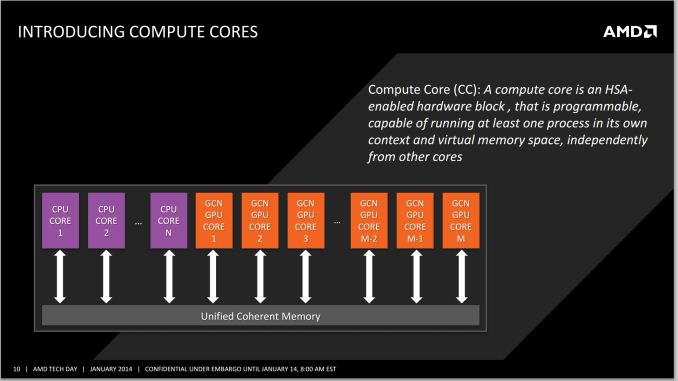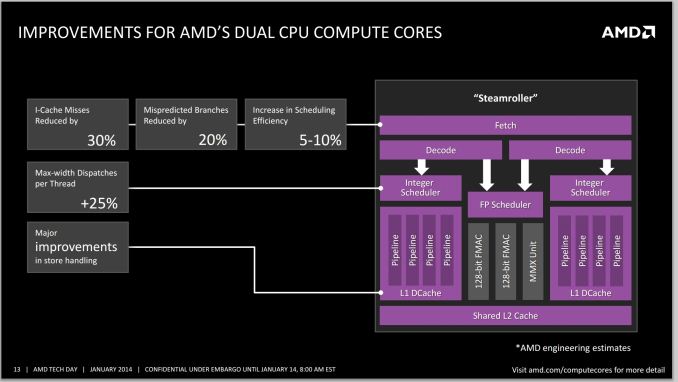AMD Kaveri Review: A8-7600 and A10-7850K Tested
by Ian Cutress & Rahul Garg on January 14, 2014 8:00 AM ESTKaveri and Counting Cores
With the move towards highly integrated SoCs we've seen a variety of approaches to core counts. Apple, Intel and Qualcomm still count CPU cores when advertising an SoC. For Apple and Qualcomm that's partially because neither company is particularly fond of disclosing the configuration of their GPUs. More recently, NVIDIA took the somewhat insane stance of counting GPU CUDA cores on its Tegra K1 SoC. Motorola on the other hand opted for the bizarre choice of aggregating CPU, GPU and off-die companion processors with the X8 platform in its Moto X smartphone. Eventually we will have to find a way to characterize these highly integrated SoCs, particularly when the majority of applications actually depend on/leverage both CPU and GPU cores.
AMD finds itself in a unique position with Kaveri where it has a truly unified CPU/GPU architecture and needs to establish a new nomenclature for use in the future. With 47% of the Kaveri die dedicated for GPU use, and an architecture that treats both CPU and GPU as equals, I can understand AMD's desire to talk about the number of total cores on the APU.
AMD settled on the term "Compute Core", which can refer to either an x86 (or maybe eventually ARM) CPU core or a GCN compute unit. The breakdown is as follows:
- Each thread on a CPU is a Compute Core
- Each Compute Unit on the IGP is a Compute Core
- Total Compute Cores = CPU Compute Cores + IGP Compute Cores
This means that the high end SKU, the A10-7850K will have a total of 12 compute cores: four from the CPU (two Steamroller modules supporting four threads) and eight from the IGP (due to eight compute units from the R7 graphics).
There are some qualifications to be made on this front. Technically, AMD is correct – each compute unit in the IGP and each thread on the CPU can run separate code. The Hawaii GCN architecture can spawn as many kernels as compute units, whereas a couple of generations ago we were restricted to one compute kernel on the GPU at once (merely with blocks of work being split across the CUs). However, clearly these 12 compute units are not equivalent: a programmer will still have to write code for the CPU and GPU specifically in order to use all the processing power available.
Whenever AMD (or partners) are to promote the new APUs, AMD tells us clearly that two sets of numbers should be quoted in reference to the Compute Cores – the total, and the breakdown of CPU/GPU on the APU. Thus this would mean that the A10-7850K APU would be marketed at a “12 Compute Core” device, with “(4 CPU + 8 GPU)” following immediately after. I applaud AMD's decision to not obfuscate the internal configuration of its APUs. This approach seems to be the most sensible if it wants to tout the total processing power of the APU as well as tell those users who understand a bit more what the actual configuration of the SoC is. The biggest issue is how to address the users who automatically assume that more cores == better. The root of this problem is very similar to the old PR-rating debates of the Athlon XP. Explaining to end users the intracacies of CPU/GPU programming is really no different than explaining why IPC * frequency matters more than absolute frequency.
When a programmer obtains an APU, the OpenCL profiler should locate the eight compute units of the GPU and display that to the user for offloading compute purposes; at the same time it is up to the programmer to leverage the threads as appropriately as possible, even with AMD’s 3rd generation Bulldozer modules implementing a dual-INT + single-FP solution.
At launch, AMD will offer the following configurations:
- A10-7850K: 12 Compute Cores (4 CPU + 8 GPU)
- A10-7700K: 10 Compute Cores (4 CPU + 6 GPU)
- A8-7600: 10 Compute Cores (4 CPU + 6 GPU)
The problem with distilling the processing power of the APU into a number of compute cores is primarily on the CPU side. AMD will be keeping the GPU at approximately the same clock (720 MHz for these three) but the CPU frequency will differ greatly, especially with the A8-7600 which has configurable TDP and when in 45W mode will operate 300-400 MHz less.
Steamroller Architecture Redux
We've already documented much of what Steamroller brings to the table based on AMD's Hot Chips presentation last year, but I'll offer a quick recap here.
Steamroller brings forward AMD's Bulldozer architecture, largely unchanged. We're still talking about a dual-core module featuring two independent integer execution cores with a single shared floating point execution core capable of executing instructions from two threads in parallel. A single module still appears as two cores/threads to the OS.
In Bulldozer and Piledriver, each integer core had its own independent scheduler but the two cores shared a single fetch and decode unit. Instructions would come in and decodeded operations would be fed to each integer pipe on alternating clock cycles. In Steamroller the decode hardware is duplicated in each module, so now each integer core gets its own decode unit. The two decode units are shared by the one FP unit.
L1 instruction caches increase in size from 64KB to 96KB per module, which AMD claims reduces misses by up to 30%. There's an updated branch predictor which is responsible for reducing mispredicted branches by up to 20%. Both integer and FP register files grow in size as well as an increase in the size of the scheduling window, a combination of which increases the number of dispatches per thread by up to 25%.
There are huge improvements on the store side. Steamroller can now issue up to 2 stores at the same time compared to 1 in Bulldozer/Piledriver. The load/store queue sizes go up by around 20% as well. It's remarkable just how much low hanging fruit there was in the Bulldozer design.
GCN in an APU
The integrated graphics solution on Trinity/Richland launched with a Cayman-derived VLIW4 architecture, which unfortunately came just shortly after desktop side of the equation finished moving from VLIW5/VLIW4 to GCN. Having a product stack with largely different GPU architectures doesn't help anyone, particularly on the developer front. Looking forward, sticking with GCN was the appropriate thing to do, as now Kaveri is using GCN, the same architecture found in AMD’s high end R9-290X GPU, based on the Hawaii platform.
This enabled AMD to add in all the features they currently have on Hawaii with little to no effort – the TrueAudio DSP, the upgraded Video Coding Engine and Unified Video Decoder are such examples. Whether or not AMD decides to develop an APU with more than 8 GCN CUs is another matter. This is a point we've brought up with AMD internally and one that I'm curious about - do any AnandTech readers have an interest in an even higher end APU with substantially more graphics horsepower? Memory bandwidth obviously becomes an issue, but the real question is how valuable an Xbox One/PS4-like APU would be to the community.














380 Comments
View All Comments
HanzNFranzen - Saturday, January 18, 2014 - link
Yea, 90% of people use Battlefield 4 90% of their time on the PC... You missed the question.keveazy - Saturday, January 18, 2014 - link
Doesn't matter.If you buy a PC, it's better to make sure it's solid and ready to handle applications that require strong physical cpu performance unless your still living the 90s dude.
My point is, AMD's highest end kaveri 7850k chip today is priced at the same range as Intel's low end i5 cpus. From here, you take your pic. If you wanna have a system that has worse graphics than ps4, go AMD.
kmi187 - Sunday, January 19, 2014 - link
If you've actually lived in the 90's you would know that cpu power was a lot more important back then than it is now. You didn't have hardware (gpu) acceleration for video and all that jazz to put less stress on the cpu.Also you do realize the PS4 runs on AMD hardware right?
medi02 - Tuesday, January 28, 2014 - link
What on earth are you talking about? What is a "solid PC"? One that fails at games?cryptik - Monday, March 30, 2015 - link
Today (30 Mar 2015) the AMD A8-7600 is the same price ($99) as the Intel Pentium G3460. The "lowest end" i5 CPU is $189. You're simply a liar who has no idea what he's talking about.vAngz - Sunday, January 26, 2014 - link
I believe you and others are missing the point. Can you play Battlefield 4 on medium settings @ 1080p using only the i5 4430, without using a discrete graphics card, and it still be playable above 30fps?Even though the chips are the same price (at most places), you can actually play BF4 using only the A10 7850K, which is not possible with the i5 4430. I bring this up mainly because you brought up BF4. When, rather if, Mantle is ever activated on BF4, things will change and we will see even better performance on the A10-7850K and later gen AMD APUs.
So, yes, you can get better performance out of the i5 4430, but you will need to spend more money on a discrete graphics card to use it for gaming, such as for BF4. I believe this what sets the AMD APUs apart from Intel offerings at the moment. We need to compare apples to apples.
I could be wrong, but I haven't seen anywhere in my research where anyone is getting that kind of performance out of i5 4430 without a discrete graphics card added into the mix. If you have a link on such info please share it with us. Thanks.
keveazy - Friday, February 7, 2014 - link
Your not getting it either. My mistake in my previous post is I didn't mention Battlefield 4 Multiplayer.That's where the APU will fail. It will fail in both the Cpu performance and Gpu performance. The APU is still the better choice at light gaming.
theduckofdeath - Wednesday, January 15, 2014 - link
I think he's referencing that processor simply because it's a pretty powerful, fairly low-priced processor for all of those who can live without all of those over-clocker tweaks...just4U - Tuesday, January 14, 2014 - link
You talk about 2500K performance and yet the majority of people I come across are not even working with that. The vast majority are still in the C2D/8800 like performance arena. What would be nice to see from some of these review sites in their performance analysis is if stuff like this makes sense to finally bite the bullet and get rid of the old dog..just4U - Tuesday, January 14, 2014 - link
Ian .. that's something I think you should look at btw.. we do get a fair number of lurkers /w some posting up questions like that about how it compares to the old warhorses their on. Hell even for those of us with old parts kicking around it's something to consider. Do we scrounge up some cheap ddr2 psu.. hand me down hard drives and pair it up for that box in front of the television or do we say no.. this makes far more sense and it's new.